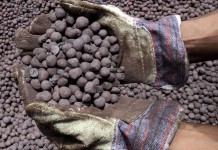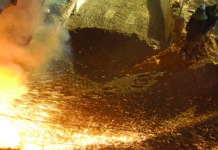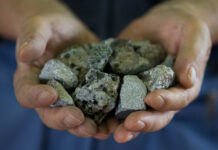
[miningmx.com] – RIO Tinto reported on Tuesday near-flat production growth of iron ore for the fourth quarter, weaker than some market expectations amid concerns that Chinese demand is softening.
Rio Tinto, the world’s second biggest producer of the steel-making commodity after Vale of Brazil, reported a 3% rise in output between the third and fourth quarters of 2011, down from growth of nearly double that at the end of 2010.
That was much less than some commodities analysts had expected, with one analyst having tipped a rise of 20% as Rio Tinto continues to expand its iron ore operations, which are based predominantly in the northwest of Australia.
The result matched several other analysts’ expectations, though market forecasts had varied widely. One analyst doubted that too much could be read into the numbers in any case, saying Rio Tinto had little choice but to run mines at full tilt.
“Once you start a programme of development, unfortunately it’s pretty difficult to suddenly stop and they’ve got to follow it through and even if they get to a point where they are producing into a glut market they’ve just got to ride it out,” Fat Prophets mining analyst David Lennox said.
Rio Tinto’s Australia-listed stock closed 1.25% higher in line with the broader market.
“The market took the result very well, the result was good without being spectacular,” said Michael Heffernan, senior client adviser and strategist for Austock Group in Sydney.
Rio Tinto gave no detailed commentary on demand or China, its biggest single market, in giving production data for the December quarter, but there are market concerns that Chinese commodity imports will fall this year as domestic growth eases.
Earlier on Tuesday, Chinese data showed the world’s second-biggest economy grew at its weakest pace in 2-1/2 years in the latest quarter and it appeared headed for an even sharper slowdown in the coming months.
Chinese steel producers in particular are expected to suffer from low profitability in the quarter ending March 31.
However, Rio Tinto, Vale and number-three iron ore miner BHP Billiton are counting on strong long-term Chinese demand to underpin multi-billion-dollar expansion projects, with their overall confidence in China undimmed.
MAJOR NEW IRON ORE PROJECTS
Rio Tinto alone plans to spend $15bn this year on projects across its portfolio, with a large chunk of this expected to be spent in iron ore. It expects to produce 283 million tonnes of iron ore by 2013, up 15.5% from 2011.
That would place Rio Tinto at near par with the current output of Vale at 308 million tonnes, though the Brazilian miner aims to boost iron ore output to 469 million tonnes by 2015.
In comparison, BHP Billiton is earmarking a rise to 220 million tonnes a year from around 155 million now.
BHP’s December-quarter iron ore output could be up by as much as 23% when it reports on Wednesday, analysts say.
Earlier on Tuesday, Australia’s third-largest iron ore producer, Fortescue Metals Group, reported a 19% jump in December-quarter shipments from the previous quarter to 14.8 million tonnes as it also expanded.
Based on analysts’ forecasts, Rio Tinto is expected to report full-year 2011 earnings before interest and tax of around $23bn, up from $21.1bn in 2010.
Rio Tinto said its fourth-quarter output of hard coking coal, also used in steel making, fell 5% between the third and fourth quarters though it was up 16% from a year earlier when production was hurt by heavy rains.
Thermal coal for power generation mined in Australia fell 3% on the third quarter and 14% from a year earlier.
Lower grades at Rio Tinto’s 30%-owned Escondida mine in Chile left full-year mined copper production slightly under guidance at 519,700 tonnes, down 23% from 2010.
Rio Tinto’s share of mined copper production from the Escondida mine dropped 14% to 65,300 tonnes in the fourth quarter from a year earlier, the company said.
Rio Tinto also noted it had cut its overall aluminium capacity by 462,000 tonnes a year. Its 175,000-tonnes-per-year Lynemouth smelter in England is running at a reduced rate after a power cut in December knocked out more than half its capacity.
Some in the industry question whether the company will restart that lost capacity, especially after it said in November that it was set to close the Lynemouth smelter as rising energy costs put pressure on margins.
Aluminium prices are down nearly 20% over the past 12 months.











